
The wedding of Prince Albert, Duke of York and Lady Elizabeth Bowes-Lyon took place on 26 April 1923 at Westminster Abbey. The bride was a member of the Bowes-Lyon family, while the groom was the second son of King George V.

On 6 July 1893, Prince George, Duke of York, and Princess Victoria Mary of Teck were married at the Chapel Royal, St. James's Palace, in London, England.

The wedding of Princess Elizabeth and Sir Philip Mountbatten took place on Thursday 20 November 1947 at Westminster Abbey in London, United Kingdom. The bride was the elder daughter of King George VI and Queen Elizabeth as well as the heir presumptive to the British throne. The groom was born a Greek and Danish prince; he stopped using these foreign titles on his adoption of British nationality four months before the announcement of their marriage and was made Duke of Edinburgh, Earl of Merioneth and Baron Greenwich on the morning of the wedding.

The wedding dress worn by Catherine Middleton at her wedding to Prince William on 29 April 2011 was designed by English designer Sarah Burton, creative director of the luxury fashion house Alexander McQueen.

Lady Diana Spencer's bridal gown was an ivory silk taffeta and antique lace gown, with a 25-foot (7.6 m) train and a 153 yards (140 m) tulle veil, valued then at £9,000. It was worn at Diana's wedding to Charles, Prince of Wales in 1981 at St Paul's Cathedral. It became one of the most famous dresses in the world, and was considered one of the most closely guarded secrets in fashion history.

The wedding dress of Princess Alexandra of Denmark was worn at her wedding to Albert Edward, Prince of Wales on 10 March 1863 in St George's Chapel, Windsor Castle. It was the first in British royal history to be photographed while being worn. The gown was made by London dressmaker Mrs James of Belgravia. It is now part of the British Royal Collection. In 2011, the dress was part of a display of royal wedding dresses at Kensington Palace.
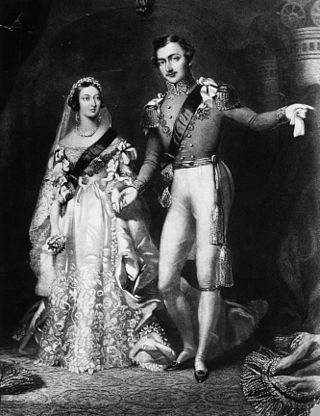
Queen Victoria of the United Kingdom married Prince Albert of Saxe-Coburg and Gotha on 10 February 1840. She chose to wear a white wedding dress made from heavy silk satin, making her one of the first women to wear white for their wedding. The Honiton lace used for her wedding dress proved an important boost to Devon lace-making. Queen Victoria has been credited with starting the tradition of white weddings and white bridal gowns, although she was not the first royal to be married in white.

On the event of her wedding to Prince Henry of Battenberg at Saint Mildred's Church at Whippingham, near Osborne, on 23 July 1885, Princess Beatrice of the United Kingdom wore a wedding dress of white satin, trimmed with orange blossom and lace, the lace overskirt held by bouquets of the blossom entwined with white heather. There was lace on the pointed neck line, and on the sleeves, for the Princess was a lover of, and an expert on, lace. One of her most treasured possessions was a tunic of old point d'Alençon which had belonged to Catherine of Aragon. Knowing her daughter's love of lace, the Queen allowed Princess Beatrice to wear the Honiton lace and veil which she herself had worn on her wedding day. It was a very precious possession to the Queen, and Princess Beatrice was the only one of her daughters to be given the opportunity to wear it. Her veil was emblazoned with a diamond circlet with diamond stars, a wedding gift from her mother.

The wedding dress of Princess Louise Margaret of Prussia was worn by her at her wedding to Prince Arthur, Duke of Connaught and Strathearn, at St. George's Chapel, Windsor, on 13 March 1879. Prince Arthur was the seventh child and third son of Queen Victoria and Prince Albert of Saxe-Coburg and Gotha.

Princess Helena, the fifth child and third daughter of Queen Victoria, wore a dress of white satin featuring deep flounces of Honiton lace, the design of which featured roses, ivy, and myrtle, for her marriage to Prince Christian of Schleswig-Holstein on 5 July 1866 at Windsor Castle, Windsor, Berkshire, England. Her headpiece was composed of orange blossom and myrtle, and the veil was also made of Honiton lace. She also wore a necklace, earrings, and brooch of opals and diamonds, a wedding gift from the Queen. Along with bracelets set with miniatures, Helena also wore the Order of Victoria and Albert.
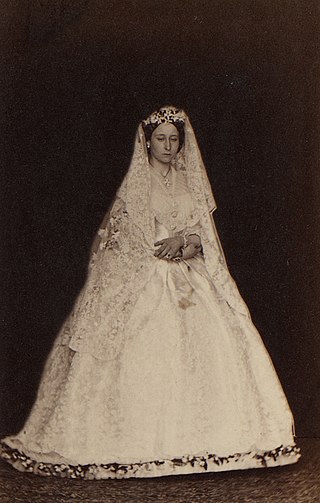
The wedding dress of Princess Alice of the United Kingdom was worn during a period of court mourning for the death of her father.
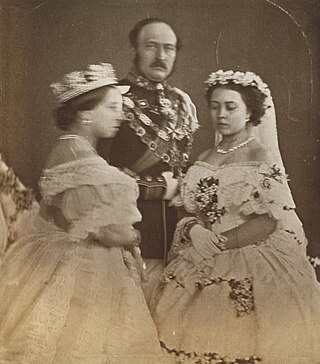
The wedding dress of Victoria, Princess Royal, was worn by the eldest daughter of Queen Victoria in 1858.

The wedding dress of Princess Helen of Waldeck and Pyrmont was worn by the bride at her wedding to Prince Leopold, Duke of Albany, on 27 April 1882 in St. George's Chapel, Windsor Castle. Prince Leopold was the youngest son of Queen Victoria and Prince Albert. Princess Helen was the daughter of George Victor, Prince of Waldeck and Pyrmont and his wife Princess Helena of Nassau.

The wedding dress of Princess Louise, Queen Victoria's sixth child and fourth daughter, was worn by her at her wedding to John Campbell, Marquess of Lorne, the heir-apparent to the 8th Duke of Argyll, on 21 March 1871 at St. George’s Chapel, Windsor Castle.

The wedding of Queen Victoria of the United Kingdom and Prince Albert of Saxe-Coburg and Gotha took place on 10 February 1840 at Chapel Royal, St. James's Palace, in London.
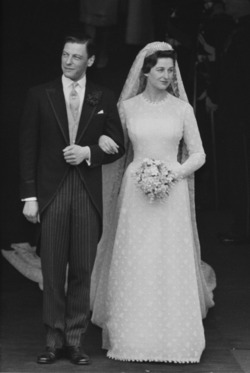
The wedding of Princess Alexandra of Kent and The Honourable Angus Ogilvy took place on Wednesday, 24 April 1963 at Westminster Abbey. Princess Alexandra was the only daughter and second child of Prince George, Duke of Kent, and Princess Marina of Greece and Denmark, while Ogilvy was the second son and fifth child of the 12th Earl of Airlie and Lady Alexandra Coke.
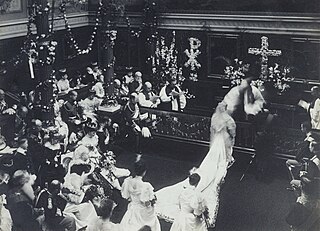
The wedding dress of Princess Maud of Wales was worn at her wedding to Prince Carl of Denmark on 22 July 1896 in the Private Chapel at Buckingham Palace. Maud was the youngest daughter of Albert Edward, Prince of Wales and Alexandra, Princess of Wales; Carl was the second son of Crown Prince Frederick and Crown Princess Louise of Denmark.

The wedding of Prince Henry, Duke of Gloucester, and Lady Alice Montagu Douglas Scott took place on Wednesday, 6 November 1935, in the private chapel at Buckingham Palace. A larger public ceremony had been planned for Westminster Abbey, but plans were scaled back after the bride's father, the 7th Duke of Buccleuch, died of cancer on 19 October.

The wedding of Princess Mary, and Henry Lascelles, Viscount Lascelles took place on Tuesday, 28 February 1922, at Westminster Abbey. The bride was the only daughter of King George V, while the groom was a member of the Lascelles family.

The wedding of Prince George, Duke of Kent, and Princess Marina of Greece and Denmark took place on Thursday, 29 November 1934, at Westminster Abbey. The Duke of Kent was the fourth son of King George V and Queen Mary, while Princess Marina was the youngest daughter of Prince Nicholas of Greece and Denmark and Grand Duchess Elena Vladimirovna of Russia. The couple were second cousins through mutual descent from King Christian IX of Denmark.






















